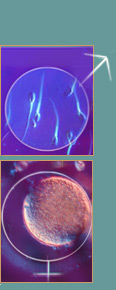|

|


|
|
Fertility Throughout Life
by Lexi Krock
Fetus
Male: By the tenth week of pregnancy, a fetus's gender is
evident, and by week 14 sex organs have formed.
Female: At 20 weeks, a female fetus has a fully developed
reproductive system, replete with six to seven million
eggs.
Infant
Male: Boys do not produce sperm until puberty, so a male
infant's reproductive system is largely unchanged between
the fetal stage and infancy.
Female: At birth, a girl's pair of ovaries contain up to
1,000,000 follicles, which are hollow balls of cells, each
with an immature egg (or ovum) in the center. A girl is born
with all the eggs she will ever have.
Adolescent
Male: While women are only fertile during a few days in
their menstrual cycles, men are constantly fertile from the
onset of puberty (usually at 10 years of age) when a surge
in testosterone triggers the production of an average of 200
million sperm each day. Sperm cells mature in the
epididymis, a 20-foot-long series of thin, tightly coiled
tubes. Sperm take from two to 12 days to pass through the
epididymis and to develop the ability to swim and fertilize.
From start to finish, the production of a single sperm can
take up to 72 days.
Female: During childhood, a girl's ovaries absorb almost
half of the 1,000,000 immature eggs with which she was born.
Of the 400,000 eggs present during her first menstrual
period, only 300 to 500 of them will develop into mature
eggs across her reproductive life span. Her body reabsorbs
the rest before they complete development.
Ovulation and menstruation start near the end of puberty,
generally when a girl is about twelve-and-a-half, though any
age from nine to 18 is normal. Each month during a woman's
reproductive years, ten to 20 follicles begin maturing under
the influence of hormones. These hormones, which are low
during childhood and increase exponentially during the
reproductive years, regulate the entire reproductive
process.
Two distinct cycles govern menstruation and ovulation, the
uterine cycle (commonly called the menstrual cycle) and the
ovarian cycle, which is responsible for ovulation. Hormones
coordinate these two cycles, which last from 20 to 40 days
each to prepare the lining of the uterus (endometrium) each
month for a possible conception.
Ovulation generally occurs about two weeks after the last
day of a woman's menstrual period. A follicle discharges a
single egg to the surface of the ovary, whence it is slowly
carried down the fallopian tube and into the uterus. This
process lasts about two days, after which conception is not
possible. If the egg reaches the uterus without
fertilization by a sperm, it will pass unnoticed out of the
woman's body. If fertilization occurs, the egg will embed
itself in the endometrium and begin its growth.
Twenty-something
Male: Both men and women are normally at their peak of
fertility in their early to mid-20s.
Female: Though girls menstruate throughout their teens, many
women do not regularly ovulate until their mid-20s, when
hormone levels become more regular and women begin to
ovulate each month.
Thirty-something
Male: Male fertility in the 30s is much the same as in the
20s.
Female: Though many women conceive and give birth to healthy
babies into their 40s, conception becomes more difficult for
women in their mid-to-late 30s and early 40s, and women over
35 are more likely to carry a baby with abnormalities.
Middle-age
Male: While women's fertility in middle age begins to
decrease, men of the same age are still highly fertile.
Female: Menstruation and ovulation continue until the age of
50, on average, but any time between 40 and the late 50s is
a normal age to begin menopause. The body changes that occur
between the reproductive and post-reproductive phases of a
woman's life, most notably the end of monthly bleeding, are
called the "climacteric" and often take place over as many
as 15 years. During the gradual process of menopause, the
ovaries stop maturing eggs and releasing large amounts of
hormones. A woman is not considered to have completed
menopause until she has passed one full year with no period.
Once menopause is complete, a woman can no longer conceive a
child.
Old age
Male: Men are capable of fathering healthy children
throughout their lives. It is not uncommon, however, for
older men to experience some sexual dysfunction. In
addition, some studies have shown that children conceived by
a father over the age of 50 have an increased risk for
mental illness, particularly schizophrenia.
Female: Post-menopausal women carry some eggs in their
ovaries, but they are not viable and cannot be fertilized.
Many women take hormones during and after menopause in order
to ease the process of menopause and help prevent
post-menopausal bone-density loss. However,
hormone-replacement therapy does not maintain a woman's
fertility into old age.
Lexi Krock is editorial assistant of NOVA Online.
The 18 Ways (And Then Some)
|
On Human Cloning
|
Fertility Throughout Life
|
How Cells Divide
Resources
|
Teacher's Guide
|
Transcript
|
Site Map
|
18 Ways to Make a Baby Home
Search |
Site Map
|
Previously Featured
|
Schedule
|
Feedback |
Teachers |
Shop
Join Us/E-Mail
| About NOVA |
Editor's Picks
|
Watch NOVAs online
|
To print
PBS Online |
NOVA Online |
WGBH
©
| Updated October 2001
|
|
|
|